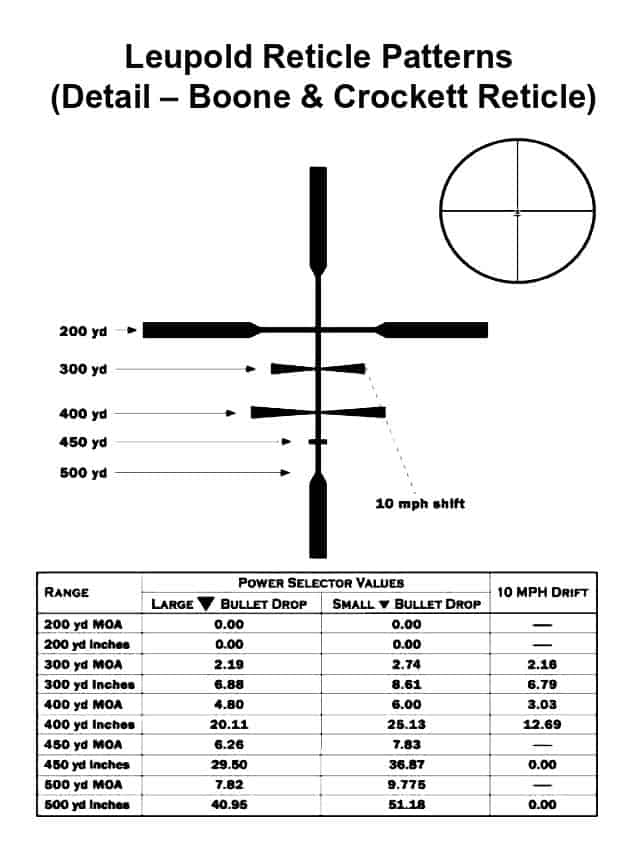Did you know that the record for the longest sniper shot ever was broken last year by a Canadian sniper who took out an ISIS soldier from 3,540 meters?! There’s no doubt that this amazing marksman was using some of the best equipment out there to make such an astounding shot, and if you’re looking for tools to help you shoot longer and farther than you previously thought possible, you may want to check out the Boone and Crockett reticle. In this article, we’ll be covering the details of how to use the Boone and Crockett reticle to make your longest shot yet.
WHAT’S A RETICLE? WHY BOONE AND CROCKETT’S?
Great question. A reticle, also known as the “crosshairs”, is the part of your scope that aids you in locating the exact center of your sight-picture and knowing precisely what you’re aiming at. Scopes–telescopes, binoculars, microscopes, etc–are extremely helpful in magnifying objects to see them better; but reticles are extremely helpful in determining where your bullet will land on the magnified object.
WHAT SETS THE BOONE AND CROCKETT RETICLE APART?
Another great question! The nice thing about the Boone and Crockett reticle is that it’s an advanced BDC (bullet drop compensator) reticle that, with a little practice, can help you quickly and accurately gauge the distance and elevation to your target and get accurate shots downrange…all without taking your eyes off the scope or adjusting your turrets. BDC reticles are helpful in that they are a quick and user-friendly way to utilize good ole-fashioned Kentucky windage and Arkansas Elevation to more accurately adjust your holdover.
THE VIEW BEHIND THE BOONE AND CROCKETT RETICLE
For a quick view of a guy glassing some terrain with the Boone and Crockett reticle equipped, check out the video below (quick note: he’s a bit wordy, so skip ahead to about the six-minute mark.)
In short, this is what you’ll see after equipping your new reticle (minus the convenient little labels describing the elevation and distance posts):
The central image is your actual reticle, with the top-corner image being the reticle within the frame of your scope.
Those hashes along the six o’clock post are holdover marks so that you can quickly adjust your aim to account for your target’s distance, and their fattened edges represent the adjustment for windage for up to 10 MPH.
This series of posts and hashes can be confusing at first, but they can also be extremely useful for crude BDC if you’ve got your scope and rifle zeroed in for the caliber of load you’re using.
Pro Tip: zeroing in your scope for the specific load you are using is absolutely essential for the Boone and Crockett reticle to be accurate. You can’t just screw this thing onto the end of your scope and expect the hold-points to be accurate. Lucky for us though, Boone and Crockett provides a handy little reference guide so that you can make the adjustments you need to before going out on the range and wasting a bunch of ammo trying to guess your way towards the perfect zero.
UNCOMPLICATING THE ABOVE
While the Boone and Crockett reticle is designed to help you size up your target on the go and adjust for windage and elevation manually without having to mess around with any fancy doohickeys on your scope, it does take some work to initially set up. But trust us, it’s worth it.
So. If your goal is to just go out and shoot some big game without worrying about math and scope adjustment and whatnot, stick with us. Take note of the caliber of your ammunition, refer to the chart above, and get to a range. This is the most important step. Spend some time and ammo carefully zeroing in your rifle and testing out how accurate the hold-points and windage points are for you–that way you’re not in for any unpleasant surprises when you actually get out into the field. That bullet drop chart can be confusing, but it gives a rough estimate (in inches or MOA) for how much to compensate for in elevation depending on bullet size.
One last Pro Tip: when zeroing in, if you can spare the money, spend a couple boxes of ammo at the range before hunting to ensure your new scope and/or reticle won’t shift anymore (if it was gonna shift, it would have as you fired a hundred rounds through it!)
ADJUSTING FOR ELEVATION
This video, while not detailing how to use the Boone and Crockett reticle, is an excellent quick-reference for how to adjust for elevation using a simple BDC reticle. After wrapping your mind around the initial concept of adjusting for elevation with a BDC, the great thing about your new Boone and Crockett reticle is that it’s pretty self-explanatory after a precursory glance at the yardage and windage labels.
Once you’re zeroed in accurately, if you’re aiming at a target 300 yards away, aim slightly above your target and center the first hold-point (below your central crosshairs) on your target. Slowly squeeze on that trigger and watch as your round drops perfectly into the target over hundreds of yards! Employ the same method for targets at 400, 450, or 500 yards out, respectively, using the lower hold-points.
ADJUSTING FOR WINDAGE
If you’ve read this far, chances are you’re an avid Kentucky windage user, and the Boone and Crockett reticle should only help you in your endeavors! The far ends of the left and right hold-points on each vertical-axis-distance-hold-point account for windage at 10 mph, so if you’ve got a ten mile per hour gust coming at you from your left, simply scan your reticle to the left of your target and center it on the edge of the appropriate horizontal-axis-hold-point.
Ahem…we understand that that last sentence was a bit of a doozy, but once you’re actually on the range it’s pretty intuitive: if the wind’s blowing left, aim left along the axis and your bullet will be course-corrected on its own (and vice-versa.)
Conclusion
Today we’ve taken an in-depth look at how to use the Boone and Crockett reticle, an excellent choice for a more advanced BDC reticle and a handy tool for fans of holdover shooting. If you’re willing to put the time in upfront at zeroing in your rifle and learning how your specific weapon, ammo, and shooting style affects the accuracy of the yardage and windage of the hold-points, the Boone and Crockett reticle can really up your game in eyeballing long distance targets in windy terrain without having to stop and adjust your scope turrets!
If you enjoyed this article you’ll probably like these:




